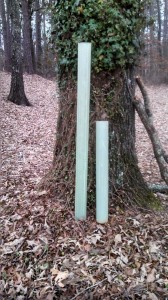It continues to irk me that even though I have been in the tree tube business for 24 years that my customers are better at explaining their benefits than I am.
I received a text over the weekend from an American chestnut tree planter in Mississippi that does a better job of illustrating the concept of the “deer browse line” better than I can. Here’s the photo and text he sent to me:

Here’s a large oak in the yard covered with English ivy. Every year at by this time the dear have browsed the ivy as shown. The tubes in the picture are 3 feet and 5 feet. This is not a completely scientific example of tube protection by height. Deer are able to rear and rest their front feet on the tree’s large trunk. They are not able to do this with a tree tube. It probably does show the 5 footer to be practically 100% effective in stopping deer browse.
For years I have joked, when asked if I recommend 4ft or 5ft tree tubes, that the deer browse line is located 4’8.5″ from the ground. Well, here’s a place where year after year the deer, who can rest their front hooves against the big oak while rearing on their hinds, browse to almost exactly that level.
Does that mean you should always and only use 5ft tubes? No. Four foot tubes make sense a) in places with less severe deer browse, b) for species that aren’t browsed as heavily, or b) where it becomes a budgetary choice between protecting more trees with 4ft tubes versus fewer trees with 5ft tubes.
There are also a small number of cases where 6ft tree tubes are absolutely necessary, due to extreme deer density, highly preferential browse species (especially fruit trees), and topography (a steeply sloped site effectively makes deer “taller” on the uphill side of the tree tube).
But this photo and the the extremely observant text that came with it perfectly illustrate – better than I ever could – how the 5ft tree tube should be the “go to” size for deer protection in most cases and when budget allows.
